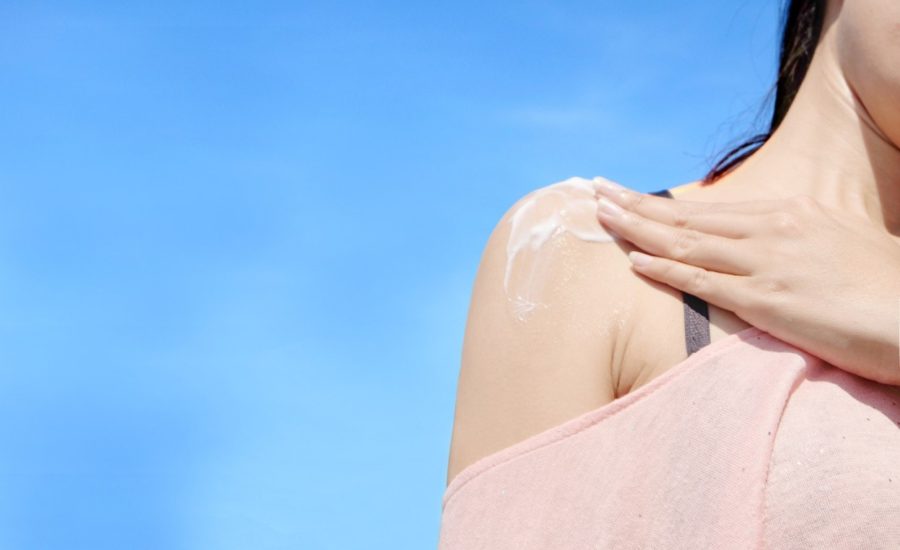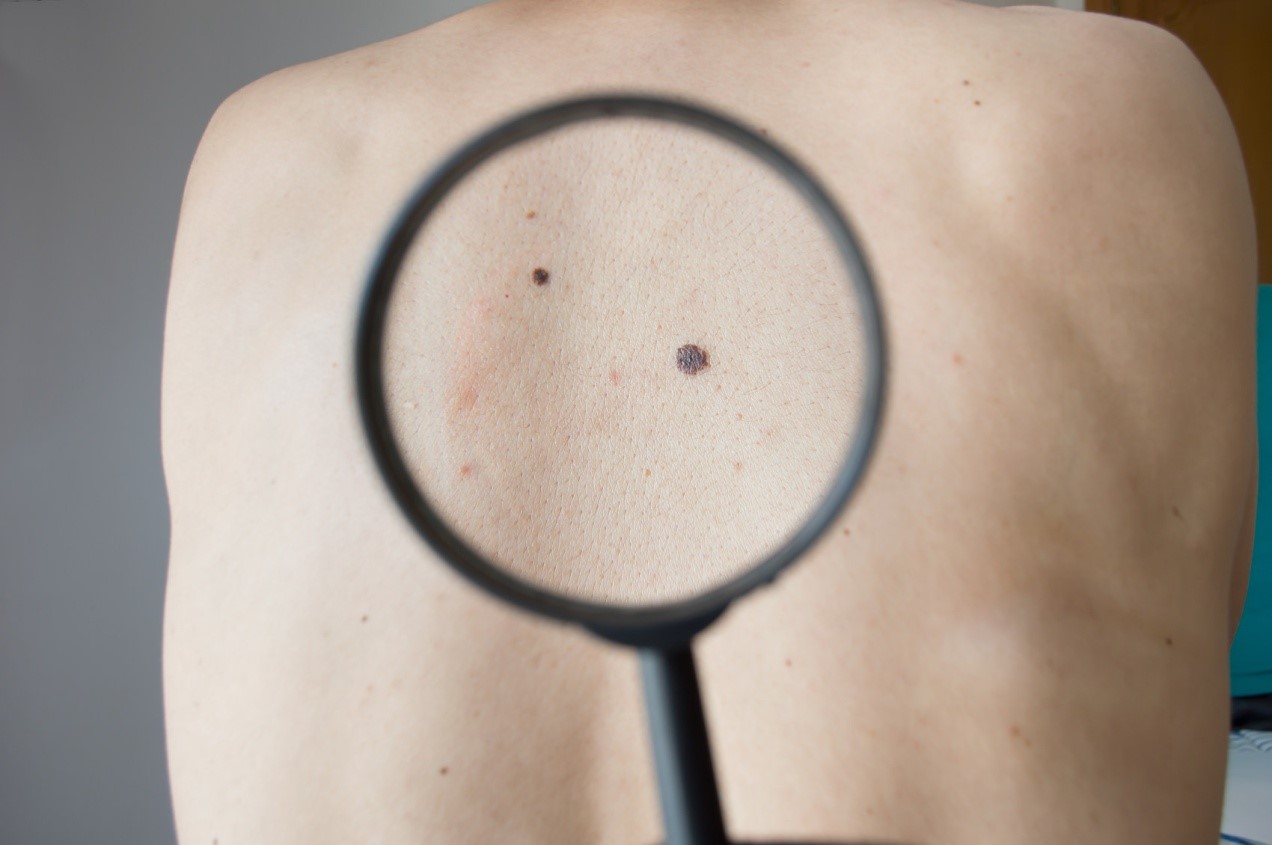Detect
Are You Wearing Enough Sunscreen to Protect Yourself from Cancer?

Planning a day out on the trail or lounging at the beach? Grabbing sunscreen and a hat is the best decision you can make for your health.
According to the American Cancer Society, more people are diagnosed with skin cancer in the USA every year than all other cancers combined. And many of these more than 5 million cases could have been prevented by using protection against sun exposure and avoiding indoor tanning devices.
Fortunately, skin cancer is easily detected and very treatable during its early stages. There are many ways you can monitor and protect your skin while enjoying the great outdoors.

Types of Skin Cancer
The outer layer of skin (epidermis) is made of three different types of cells. Each can be affected by cancer in different ways:
- Squamous cells are the thin, flat cells that make up most of the outer layer of skin and are constantly shed by your body.
- Basal cells are the round cells underneath the squamous cells, that replace them as they are shed. As basal cells move to the top layer, they change into squamous cells.
- Melanocytes make the pigment (melanin) which gives your skin its color. Sun exposure causes these cells to make more melanin and tans your skin. Melanomas are cancers that develop from melanocytes. These cells can also form benign (non-cancerous) growths called moles.
The most common skin cancers are basal and squamous carcinomas. Both are mainly found on parts of the body exposed to the sun most often, like your face and neck.
While these cancers are less likely to become life threatening than other skin cancers, it’s still important to find and treat them early. Untreated, they can deform and impair nearby tissues and organs.
Melanomas can occur anywhere on the body, but is most common on the trunk (chest and back) for men and the legs for women.
While less common, melanomas are more likely to be fatal. Melanoma kills more than 9,000 people each year in the United States, and those numbers are continuing to climb.
Like basal and squamous cell cancers, melanoma can be very curable in its early stages. But once it spreads to other parts of the body it may become difficult to treat.
The skin cancers that account for less 1% of diagnosis include:
- Merkel cell carcinoma
- Kaposi sarcoma
- Skin lymphoma
- Skin adnexal tumors (tumors that start in hair follicles or skin glands)
- Assorted sarcomas
The Sun & Skin Cancer
The sun’s ultraviolet (UV) rays are the biggest cause of skin cancer. Skin cancers start when UV rays damage the DNA of your genes that control skin cell growth.
The damage caused by UV rays can take place years before cancer appears. Kids and teens can get too much sun exposure that might not result in cancer until years or even decades later.
There are 2 types of UV rays that are important to consider when choosing a sunscreen:
- UVA rays cause skin damage, like wrinkles, and can lead to skin cancer. Most tanning beds give off large amounts of UVA rays.
- UVB rays are the main rays that lead to sunburns and are thought to cause most skin cancer
The Best Sun Protection
We all need at least some sun exposure for our health, from getting in a good dose of vitamin D to boosting our mood. But there are a few practices you should use for safe fun in the sun:
Avoid direct exposure to the sun at its peak.
UV rays are strongest from 10 a.m. to 4 p.m., especially during late spring and early summer in North America. As a rule of thumb: if the shadow you cast when you’re outside is shorter than your height, the UV rays at that time are probably intense enough cause a sunburn.
Wear the right gear
Even more so than sunscreen, the right clothing is your best protection against UV rays. Wear a hat with at least a 3 inch brim, UV-protective sunglasses, and cover as much of your skin as possible while being comfortable.
According to the American Skin Association, the best clothes to use are dry, dark, loose fitting, and made from tightly woven fabric. There are also Ultraviolet Protection Factor (UPF) clothing designed with sun-blocking abilities.
Apply Sunscreen
Whether it’s a perfect summer day or slightly grey and cloud, always wear sunscreen! UV rays can pass through clouds and snow can reflect sunlight, so even cold weather calls for sunscreen.
Your daily grooming routine should include applying sunscreen of at least SPF 30. For the best protection, choose broad spectrum sunscreens, which protect against both UVA and UVB rays.
Sunscreen should be applied to all skin that will be exposed to the sun at least 15 minutes before going outside. You should also reapply sunscreen every 2 hours and immediately after swimming or sweating heavily (even if the sunscreen is water resistant).
Identify Medications that Make You Sensitive to the Sun
Certain drugs, called photosensitizers, may increase your skin’s sensitivity to sunlight. These medications may cause you to experience photoallergy (cause an eczema-like rash) or phototoxicity (absorb UV rays, release it into the skin, and kill cells).
Commonly used drugs that can cause phototoxicity include:
- Cordarone (Amiodarone), a medication for heart conditions
- NSAIDs (nonsteroidal anti-inflammatory drugs) like ibuprofen
- Antibiotics/acne medication in the tetracycline family, like doxycycline
There are also non-medical items that can increase your sensitivity, like some perfumes, anti-aging (retinol) products, and eating citrus fruits.
If you are currently undergoing cancer treatment, there are certain chemotherapy drugs that can affect your sensitivity as well (like doxorubicin, flutamide, 5-FU, gemcitabine, and methotrexate).
Consult your doctor if you are taking medications or using products that may make you skin more sensitive to the sun, and follow the other sun protection practices.
Detection: Check Yourself Monthly
If you have a family history of skin cancer, you should examine your skin at least monthly for any changes. Check your entire body, even areas that are don’t regularly get sun.
Normal moles are usually evenly colored, round or oval, and about the width of a pencil eraser (¼ in). Most moles are harmless, but it’s important to notice any changes (size, shape, or color) because this may mean a melanoma is developing.
The American Cancer Society advises using the “ABCDE” rule for assessing new blemishes:
- A is for Asymmetry: One half of a mole or birthmark does not match the other.
- B is for Border: The edges are irregular, ragged, notched, or blurred.
- C is for Color: The color is not the same all over and may include shades of brown or black, or sometimes with patches of pink, red, white, or blue.
- D is for Diameter: The spot is larger than 6 millimeters across (about ¼ inch – the size of a pencil eraser), although melanomas can sometimes be smaller than this.
- E is for Evolving: The mole is changing in size, shape, or color.
For basal and squamous cell cancers look for new growths, spots, bumps, patches, or sores that don’t heal after several weeks.
Contact your doctor immediately about any skin changes. Early detection makes all the difference for these easily treatable cancers.






